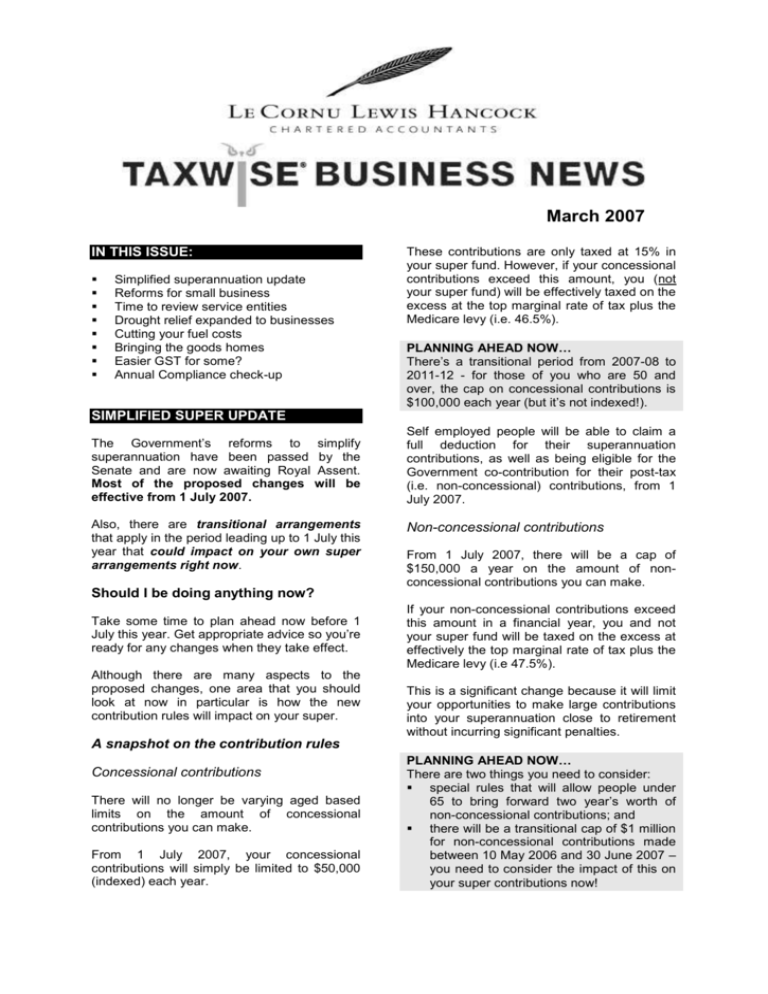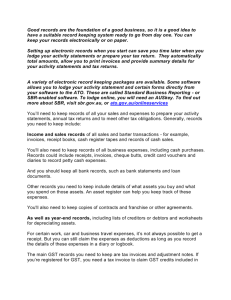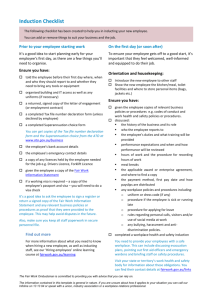Welcome to the first issue of TaxwiseTM Business News – a
advertisement

March 2007 IN THIS ISSUE: Simplified superannuation update Reforms for small business Time to review service entities Drought relief expanded to businesses Cutting your fuel costs Bringing the goods homes Easier GST for some? Annual Compliance check-up These contributions are only taxed at 15% in your super fund. However, if your concessional contributions exceed this amount, you (not your super fund) will be effectively taxed on the excess at the top marginal rate of tax plus the Medicare levy (i.e. 46.5%). PLANNING AHEAD NOW… There’s a transitional period from 2007-08 to 2011-12 - for those of you who are 50 and over, the cap on concessional contributions is $100,000 each year (but it’s not indexed!). SIMPLIFIED SUPER UPDATE The Government’s reforms to simplify superannuation have been passed by the Senate and are now awaiting Royal Assent. Most of the proposed changes will be effective from 1 July 2007. Also, there are transitional arrangements that apply in the period leading up to 1 July this year that could impact on your own super arrangements right now. Should I be doing anything now? Take some time to plan ahead now before 1 July this year. Get appropriate advice so you’re ready for any changes when they take effect. Although there are many aspects to the proposed changes, one area that you should look at now in particular is how the new contribution rules will impact on your super. Self employed people will be able to claim a full deduction for their superannuation contributions, as well as being eligible for the Government co-contribution for their post-tax (i.e. non-concessional) contributions, from 1 July 2007. Non-concessional contributions From 1 July 2007, there will be a cap of $150,000 a year on the amount of nonconcessional contributions you can make. If your non-concessional contributions exceed this amount in a financial year, you and not your super fund will be taxed on the excess at effectively the top marginal rate of tax plus the Medicare levy (i.e 47.5%). This is a significant change because it will limit your opportunities to make large contributions into your superannuation close to retirement without incurring significant penalties. A snapshot on the contribution rules Concessional contributions There will no longer be varying aged based limits on the amount of concessional contributions you can make. From 1 July 2007, your concessional contributions will simply be limited to $50,000 (indexed) each year. PLANNING AHEAD NOW… There are two things you need to consider: special rules that will allow people under 65 to bring forward two year’s worth of non-concessional contributions; and there will be a transitional cap of $1 million for non-concessional contributions made between 10 May 2006 and 30 June 2007 – you need to consider the impact of this on your super contributions now! Any concessions for small business? The $150,000 non-concessional cap will not include the proceeds from the disposal of any of your assets that qualify for the small business capital gains tax concessions, up to a lifetime limit of $1 million. Withdrawing Superannuation Benefits From 1 July 2007, superannuation benefits paid from a taxed source (generally, complying non-government superannuation fund) as either a lump sum or as a pension, will be tax free for people aged 60 and over who have retired. When you turn 65, you will be able to access your superannuation benefits tax free, even if you are still working. The compulsory cashing requirement at age 65 will be removed, generally enabling superannuation benefits to remain in a superannuation fund until the member’s death. Benefits paid from an untaxed source (mainly affecting public servants) will still be taxed, but at a lower rate than they are now for people aged 60 and over. The Reasonable Benefits Limit (RBL) system, which effectively limits the amount of superannuation benefits which can be withdrawn at concessional tax rates, will be abolished from 1 July 2007. and level of contributions meet your retirement needs; can help you prepare and implement an investment strategy that meets your superannuation targets; and can advise you whether a particular superannuation product or investment is the right financial decision for you, including advice about restructuring your superannuation needs. REFORMS FOR SMALL BUSINESS It’s an opportunity to let you know about a few initiatives that are on the Government’s drawing board during 2007. These may well have a positive impact on you if you’re a small business taxpayer. What’s a ‘small business’? As a small business operator, you may be entitled to access a number of tax concessions targeted at small business, which we have discussed from time to time in our newsletters. Currently, one of the first hurdles we have to get over is trying to work out whether your business is in fact a ‘small business’ for the purposes of a particular concession. In this regard, each concession has different entry eligibility criteria, usually based on varying levels of turnover and/or assets. Who do I talk to about my super? It’s important to get the right advice from the right person. Your tax agent or Accountant: can advise you on and help you with all tax matters in relation to your superannuation; may be able to help with some aspects of setting up your superannuation; can help you run your superannuation (e.g., prepare accounting records, produce financial statements and prepare and lodge returns if you have a self managed superannuation fund). Your solicitor/legal adviser: can help you with any legal matters and advice (e.g., in relation to setting up and running a self managed superannuation fund, such as establishing the required trust). Your licensed financial adviser: can give you advice about investment products to ensure that your investments This is confusing because what represents a ‘small business’ changes from concession to concession. It can be a costly and time consuming exercise working all this out. However, there is some relief on the horizon. Late last year, the Treasurer and Minister for Small Business announced that legislation will be introduced hopefully to make access to these concessions easier and less costly for small business. The eligibility tests that currently exist for the Simplified Tax System, Capital Gains Tax, Fringe Benefits Tax, Goods and Services Tax and Pay-As-You-Go small business concessions will be standardised. A WELCOME SIMPLIFICATION It is proposed that if your business has an annual turnover of less than $2 million, you will be able to choose to access any of these concessions that meet your business needs. All things going to plan, this simplified entry point is expected to be operative from 1 July 2007. Small business CGT concessions And speaking of small business concessions, the small business capital gains tax concessions allow you to eliminate or reduce your small business’s potential CGT in a number of ways by providing: a total exemption for a capital gain on an asset if you have continuously owned the eligible asset for at least 15 years and you’re 55 or over and retiring. a 50% reduction of a capital gain on an active asset. a retirement exemption for capital gains up to a lifetime limit of $500,000. a deferral of a capital gain if you acquire an appropriate replacement asset. SOONER RATHER THAN LATER… We raise this issue with you again because the Government is legislating proposed changes to improve the operation of these concessions. As these changes apply to eligible CGT events that happen in the 2006-2007 year, you may need to look at this area now to identify any potential tax planning opportunities. Private company loans Private company loans to shareholders or anyone linked with or related to a shareholder can be problematic, with nasty consequences for the unsuspecting. Late last year, the Government announced that it would remove the automatic debiting of a company’s franking account when a deemed dividend arises in these circumstances – this at least removes the element of double penalty. The Commissioner of Taxation will also be provided with a discretion to disregard a deemed dividend. He will be able to do this where there is evidence that you have attempted to comply with these provisions, have made an honest mistake and efforts have been made to rectify it. Standard business reporting The Treasurer has announced a new initiative to reduce the amount of reporting your business currently makes to government. The focus will be on eliminating unnecessary or duplicated reporting and improving the interface between businesses and government agencies. Working with State and Local governments, the Federal Government aims to reduce business reporting burdens by: reducing the number of different agencies to which you have to report the same or similar information; standardising and harmonising the data you have to report; and providing options for increased automation of business reporting, including greater pre-population of forms. A deemed dividend arises if a loan like this is not TIME TO REVIEW SERVICE ENTITIES Last year we alerted you to changes in the way the ATO looks at service entities. fully repaid in the same tax year in which it arises; or repaid on commercial terms where the loan is for more than a tax year. If this happens… your company’s franking account is debited; and the deemed dividend is taxable in the hands of the shareholder or associate without access to a franking credit to offset the tax paid by your company. Ouch! This effectively amounts to a double penalty overall. What’s a service entity? By way of a quick recap, it’s common for professionals (like lawyers, accountants, doctors and dentists) to set up a separate entity (e.g., a service trust or company) to provide the business with staff, clerical, administrative and other office services. What’s the problem? There’s generally nothing wrong with this type of service arrangement – it’s not all about tax and is often used as a planning strategy to protect your assets. However, the ATO has some particular views about how your service entity should operate for tax purposes. The ATO is on the look out for fees and charges levied by your service entity that are: disproportionate or excessive; calculated using arbitrary or unrealistic fixed mark-ups; and/or charged without clear evidence that the service arrangement adds value or performs any necessary functions for your business. What’s the urgency? If your business has a service entity, the ATO is giving you until 30 April 2007 to make sure it comes within its operational guidelines – so if you’re using a service entity you need to make sure everything is in place before then. AND A WORD TO THE WISE… If your service entity comes within the ATO’s guidelines, the ATO has indicated that there’s a significantly reduced risk that the ATO will audit your service entity. Even if your small business is not located in an Exceptional Circumstances designated area, you may still be eligible, provided you derive at least 70% of your income directly from farmers located in such areas. A NOTE OF CAUTION Changes to the eligibility criteria for this business support means that it’s important for you not to self-assess your potential entitlement – seek advice. You can also find out more from the Department of Agriculture and Fisheries at www.daff.gov.au/droughtassist. And for the farmers amongst you… Don’t forget that there are also a range of tax measures available to farmers affected by drought and other hardships, including: Farm management deposit accounts: these accounts allow you to manage fluctuations in primary producers’ income by a deduction for farm management deposits made in a prosperous year. When you withdraw from this account, the amount of the deduction previously allowed is included in your assessable income in the withdrawal tax year. DROUGHT RELIEF EXTENDED If you’re a farmer, you’re already aware that late last year the Government announced a revised drought relief package to assist you. Profit from forced disposal or death of livestock: you may be able to spread the profit over a number of years or elect to defer the profit to reduce the cost of replacement stock. If you’re in an area that is recognised as being severely affected by the drought (Exceptional Circumstances declared areas), you may be entitled to assistance that mainly comes in the form of income support and interest rate subsidies. Double wool clips: tax relief is available if you have the proceeds from the sale of two wool clips arising in an income year because of early shearing caused by drought, fire or flood. You may be able to defer the profit on the advanced shearing to the next income year. However, if you’re not a farmer but run a business that services them, you are only too well aware that the drought also cuts deeply into your own business. Insurance recoveries: you may be able to spread insurance recoveries received for the loss of your stock in equal instalments over five years. You may not be aware that the Exceptional Circumstances drought relief has also been recently extended to eligible small businesses. Water facilities: check whether you’re entitled to deductions for expenditure on water facilities. Does my business qualify? Landcare operations: you may be entitled to a deduction for capital expenditure you incur on eligible Landcare operations. If your business employs up to 20 staff and derives at least 70% of its income from the provision of goods and services to farmers, you may now be eligible to access this drought relief package. CUTTING YOUR FUEL COSTS What about alternative fuels? A new fuel tax credits system commenced on 1 July 2006. If you’re eligible, fuel tax credits can help cut fuel costs for your business by providing a credit for the fuel tax (excise duty) included in the price of your fuel. Fuels like liquefied petroleum gas (LPG), biodiesel, ethanol and compressed natural gas (CNG), will not be eligible for fuel tax credits until 1 July 2011, when these fuels will also be taxed. To be eligible to claim a fuel tax credit, you have to: TIP If you’re using these alternative fuels in a vehicle that’s at least 4.5 tonne travelling on a public road, you may still be entitled to a grant under the Energy Grants Credits Scheme. be registered for GST; undertake an eligible activity; and use eligible fuel. In addition: for some types of diesel vehicles you may need to meet extra environmental requirements; and to receive more than $3 million of fuel credits in a financial year, you have to sign up for the Greenhouse Challenge Plus program. This is a government and industry partnership aimed at reducing green house gas emissions. ENERGY GRANTS CREDITS SCHEME If your business was claiming under the Energy Grants Credits Scheme and you were registered for GST, you should have been automatically registered for the new fuel tax credits system. What’s an eligible activity? You may be able to claim fuel tax credits if you are using the right type of fuel for a range of eligible activities in the following areas: road transport (travelling on a public road) agriculture fishing forestry mining marine transport rail transport generation of electricity (business or commercial) nursing and medical What’s the right type of fuel? Currently, fuel tax credits mainly cover diesel and petrol that is used in a range of required circumstances (e.g., diesel and petrol for use in vehicle greater than 4.5 tonne if you’re making a public road transport claim). Other fuels like kerosene, heating oil and toluene are also eligible fuels in certain situations (e.g., burner applications such as heating). How does it work? At the risk of oversimplifying the process, your fuel tax credit is calculated by multiplying the number of eligible litres of fuel by the relevant fuel tax credit rate. At present, the standard rate is 38.143 cents per litre. The rate is reduced to 18.51 cents per litre for fuel you use in travelling on a public road in a vehicle greater than 4.5 tonne and for fuel used by emergency vehicles. How do I make a claim? If you use fuel in your business, you’ll generally claim any entitlement to fuel tax credits in your business activity statements. Once you are registered for the scheme, the ATO should include fuel tax credit labels in your activity statements to enable you to make a claim. Here’s a simple example of how the fuel tax credits system might work. Anne uses a 5 tonne truck in her business; she delivers masses of flowers and plants from the markets in outer Sydney to nurseries spread throughout the CBD and suburbs. She lodges her business activity statements quarterly. From 1 July to 30 September 2006, Anne buys 2,200 litres of diesel for her truck. Because she is travelling on public roads, the fuel tax credit rate is 18.51 cents per litre. Anne is entitled to claim a fuel tax credit of $407.22 (2,200 litres x 18.51 cents). When Anne lodges her business activity statement for the September 2006 quarter, she can claim a fuel tax credit of $407. BRINGING THE GOODS HOME Is there an easier option? Using your business’s trading stock for private or domestic purposes is not uncommon, e.g., the butcher takes home meat for the family. If you’re a baker, butcher, greengrocer, caterer or you run a restaurant, delicatessen, takeaway food shop or mixed business (e.g. milk bar, general store, convenience store), this type of record keeping can be a real hassle. You can do it if you want to but there is another way. Were you aware if you do this, the trading stock is treated as if your business has sold it to someone else and your business may end up with some unexpected income? What’s assessable? As a general rule, when you take trading stock from your business for private or domestic use and it remains owned by the same person who carries on the business, the cost of the trading stock is assessable. For instance, if you’re a sole trader and you take an item of trading stock for your personal use, you have to include the cost of that item of trading stock as assessable income in your tax return. However, if this trading stock doesn’t remain owned by the same person who carries on the business, the market value of the trading stock is assessable. Example A farmer with a livestock primary production business will often kill livestock for the family’s use and as rations for the employees. The cost of this livestock for both the family and the employees is assessable income for the farmer. However, in respect of the employees’ rations, the end result is likely to be revenue neutral because a tax deduction may also be available for the same amount. What records do I have to keep? When you take an item of trading stock from your business for private use, the ATO expects you to record: the date the item is taken from stock; the reason why the item is taken from stock; the description of the item; and the cost or market value of the item, as the case requires. Instead, if you are in one of these businesses you may be able to rely on a standard value of goods taken from your trading stock for private or domestic purposes - these are published by the ATO each year. Example Tom is a butcher, and he regularly takes home meat from his business over the income tax year for himself, his wife Margery and son Richard, who is 10. For the 2006-07 income year, the ATO’s standard value of goods taken from stock for a butcher is $980 for every adult/child over 16 and $490 for every child between 4-16. If Tom can rely on the ATO’s standard values, the ATO will consider him to have an additional $2,450 assessable income for the year ($980 x 2, plus $490). TIP The ATO’s values are only a guide. Even if you use the standard values, you should still be able to demonstrate the value applied to goods taken from your stock for private use is fair and reasonable in light of your own particular circumstances. EASIER GST FOR SOME? For those of you in a food retail business, it can be really difficult at times to account for GST when a mix of GST-free and taxable food items are sold. If you’re in this situation and using point-of-sale equipment that only provides total sales figures, you may find yourself faced with the nightmare task of having to account manually for your taxable supplies. If this is you, you may need to look at the way you’re handling this problem. You should be aware that there are some alternative GST simplified accounting methods that eligible food retail businesses may be able to utilise in this situation. These may allow you to avoid the manual calculation grind by using estimates (either supplied by the ATO or calculated by you) instead. NON-PAYMENT OF SUPER The ATO investigates on average 13,000 complaints each year from employees who believe their employers have not fulfilled their Superannuation Guarantee obligations. The ATO investigates all complaints made. Working out the details of these alternative methods is far from a simple exercise; you’ll also still have compliance obligations. So if you’re in a food retail business, consider getting advice about whether you’re eligible to use these alternative GST accounting methods and whether they’re of any benefit for your business. Disclaimer Taxwise® News is distributed quarterly by professional tax practitioners to provide information of general interest to their clients. The content of this newsletter does not constitute specific advice. Readers are encouraged to consult their tax adviser for advice on specific matters. STOP PRESS The Treasurer recently announced that these GST simplified accounting methods are also now available to restaurants, cafes and caterers from 1 October 2006. ANNUAL COMPLIANCE CHECKUP This is just a reminder that the ATO has published its Compliance Program for 2006-07. This document is a useful way of finding out what types of issues are on the ATO’s radar, so if you have any problems in the following target areas, you can fix them up before the ATO auditor comes knocking: tracking assessable income with a particular focus on pursuing business-toconsumer transactions (some strategies the ATO is currently using include matching quote books and appointments to invoices, tracing owner builder transactions through council records and matching information from trade suppliers to business); compliance by trustees of self managed superannuation funds; checking high risk refunds before they are issued (this can be a problem in the GST area); investigating the disclosure of capital gains, particularly on property and shares (the ATO is accessing property title transfer information at a State and Territory revenue authority level); and making sure employers comply with PAYG withholding, fringe benefits tax (don’t forget the office Christmas party!) and super obligations (especially Superannuation Guarantee).



